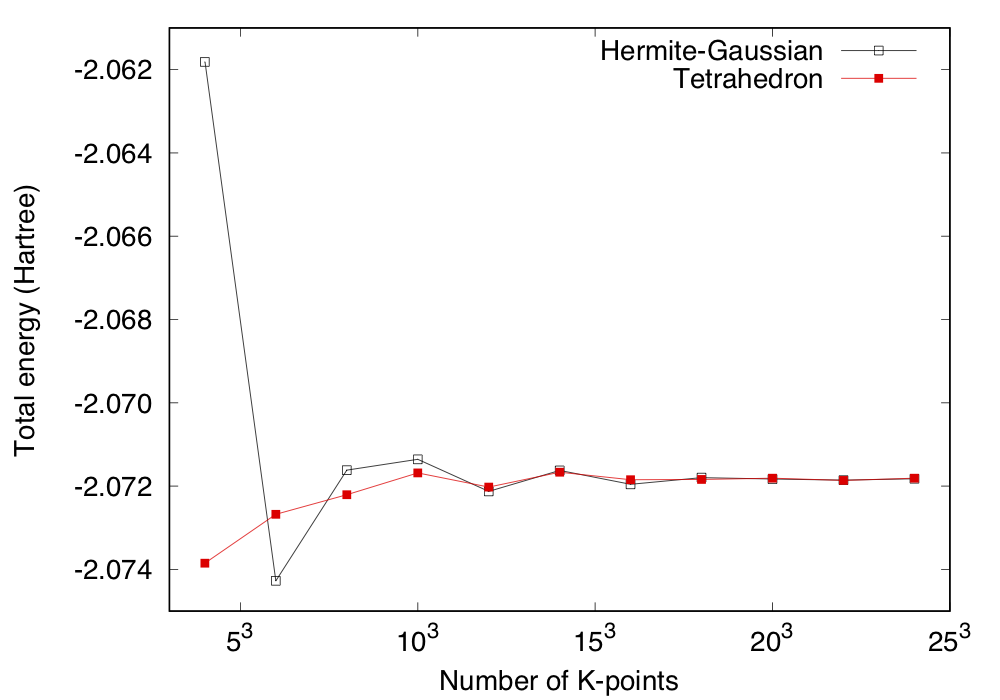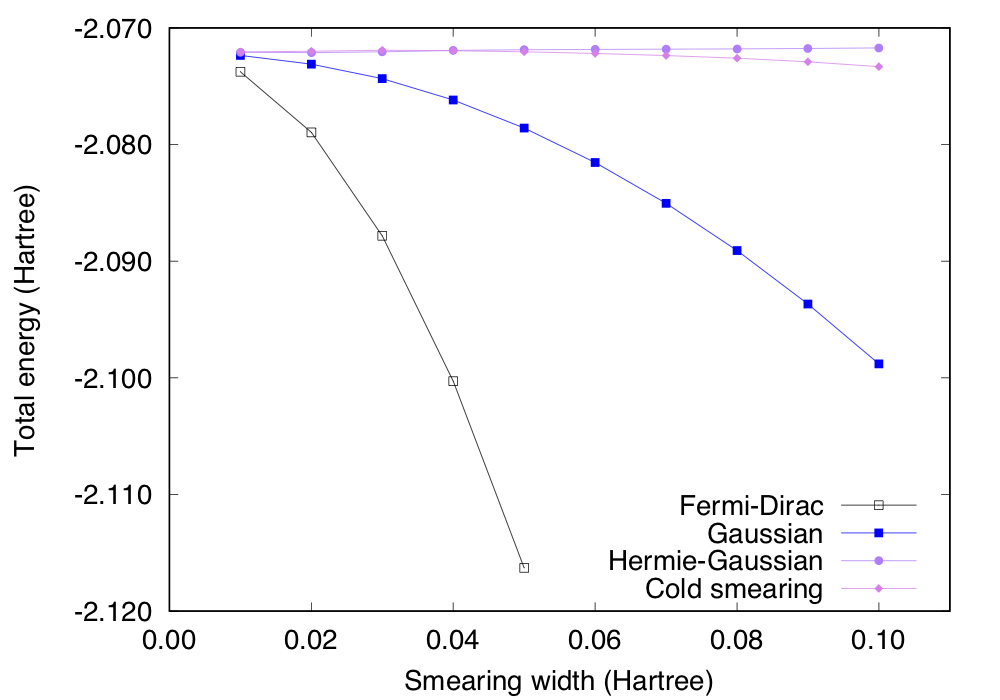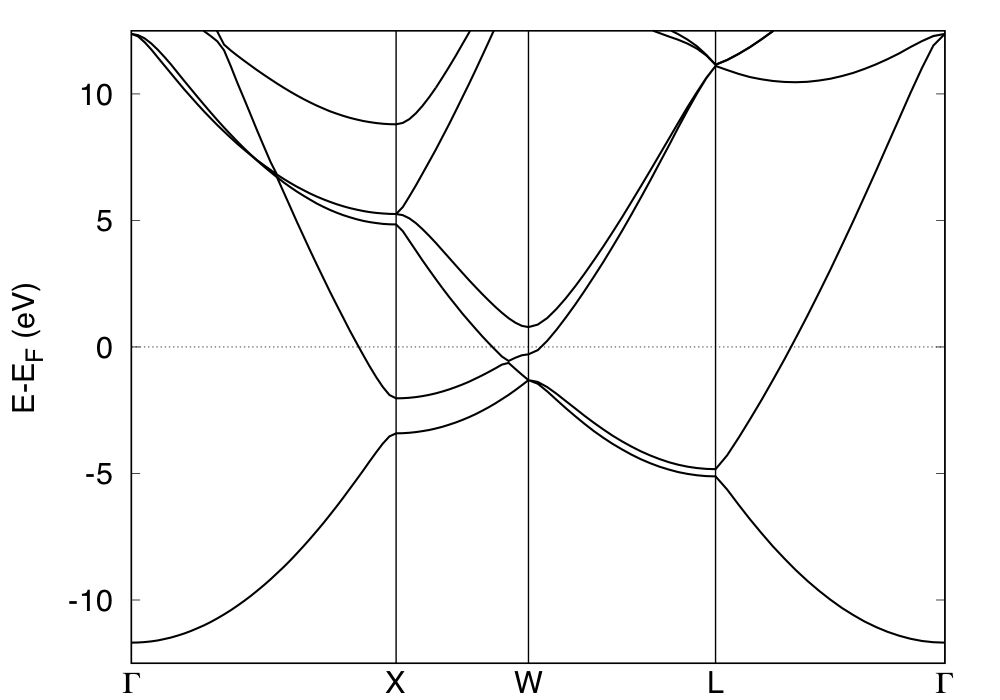- バックアップ一覧
- 差分 を表示
- 現在との差分 を表示
- ソース を表示
- STATE_tutorial/Al_jp へ行く。
- 1 (2020-11-01 (日) 10:01:38)
結晶アルミニウム †
このチュートリアルでは金属系に関するk点およびスメアリング関数を用いてフェルミ面を取り扱う際のぼかし幅について収束性のテストに関する説明を行います。 バンド構造および状態密度の計算方法も説明します。
収束性のテスト †
金属系では一般的に半導体・絶縁体に比べて多くのk点が必要になります。 さらにSTATEではフェルミ面を取り扱うために様々な関数系によるスメアリング法、あるいはテトラへドロン法の使用が可能です。
k点に関する収束性の調査 †
Here we present the convergence of the total energy with respect to the number of k-points with the Methefeesel-Paxton smearing (default) and tetrahedron methods. Use negative WIDTH (e.g. -0.02) to activate the Methefessel-Paxton smearing (with positive value, a parabolic function is used to treat the Fermi level and the entropic term is not taken into account).
- Input file for the smearing method
0 0 0 0 0 0 : I_CTRL(1:6) (DUMMY) 4.00 8.00 1 1 1 : GMAX GMAXP NTYP NATM NATM2 221 2 : NUM_SPACE_GROUP TYPE 7.5967 7.5967 7.5967 90.0 90.0 90.0 : A B C ALPHA BETA GAMMA 06 06 06 1 1 1 : N1 N2 N3 M1 M2 M3 0 0 : NCORD, NINV 0.00 0.00 0.00 1 0 1 : CPS(1,1:3) IWEI IMDTYP ITYP 13 0.50 26.98 6 1 0.2 : IATOMN ALFA AMION ILOC IVAN 0 0 0 0 0 : ICOND INIPOS INIVEL ININOS INIACC 0 1 : IPRE IPRI 30 30 0 84200.00 0 : NMD1 NMD2 LAST_ITER CPUMAX IFSTOP 6 1 : WAY_MIX MIX_WHAT 0 20 0.60 : ITER_START KBXMIX MIX_ALPHA 0.20 0.30 0.20 0.20 0.20 : DTIM1 DTIM2 DTIM3 DTIM4 DTIM 300.00 4 1 0.50D-09 : DTIO IMDALG IEXPL EDELTA -0.0020 0.50D+03 0 : WIDTH FORCCR ISTRESS ggapbe 1 : XCTYPE KSPIN 2.00 : DESTM 101 : NBZTYPE 4 4 4 : NKX NKY NKZ (DUMMY) 4 4 4 : NKX2 NKY2 NKZ2 (DUMMY) 6 : KEG 1 : NEXTST 0 : (DUMMY) 2 : IMSD 0 : EVALUATE_EKO_DIFF 0 : NPDOSAO 0 0.000 : SM_N DOPPING (DUMMY)
- Input file for the tetrahedron method
0 0 0 0 0 0 : I_CTRL(1:6) (DUMMY) 4.00 8.00 1 1 1 : GMAX GMAXP NTYP NATM NATM2 221 2 : NUM_SPACE_GROUP TYPE 7.5967 7.5967 7.5967 90.0 90.0 90.0 : A B C ALPHA BETA GAMMA 06 06 06 1 1 1 : N1 N2 N3 M1 M2 M3 0 0 : NCORD, NINV 0.00 0.00 0.00 1 0 1 : CPS(1,1:3) IWEI IMDTYP ITYP 13 0.50 26.98 6 1 0.2 : IATOMN ALFA AMION ILOC IVAN 0 0 0 0 0 : ICOND INIPOS INIVEL ININOS INIACC 0 1 : IPRE IPRI 30 30 0 84200.00 0 : NMD1 NMD2 LAST_ITER CPUMAX IFSTOP 6 1 : WAY_MIX MIX_WHAT 0 20 0.60 : ITER_START KBXMIX MIX_ALPHA 0.20 0.30 0.20 0.20 0.20 : DTIM1 DTIM2 DTIM3 DTIM4 DTIM 300.00 4 1 0.50D-09 : DTIO IMDALG IEXPL EDELTA -10.02 0 0.50D+03 0 : WIDTH FORCCR ISTRESS ggapbe 1 : XCTYPE KSPIN 2.00 : DESTM 101 : NBZTYPE 4 4 4 : NKX NKY NKZ (DUMMY) 4 4 4 : NKX2 NKY2 NKZ2 (DUMMY) 6 : KEG 1 : NEXTST 0 : (DUMMY) 2 : IMSD 0 : EVALUATE_EKO_DIFF 0 : NPDOSAO 0 0.000 : SM_N DOPPING (DUMMY)
See the difference in WIDTH.
By calculating the total energy as a funciton of the number k-ponts, we obtain the following:
Convergence with respect to the smearing width †
Total (free) energy of the metallic system is sensitive to the smearing width, in particular, with the Gaussian and Fermi-Dirac function. Here we demonstrate the smearing width dependence of the total energy, following the seminal work by de Gironcoli [Phys. Rev. B51, 6773(R) (1995)]. Smearing function can be chosen by adding the section &OTHERS ... &END at the end of the input file. To use the Fermi-Dirac distribution function set
&OTHERS FERMI_DIRAC &END
For the Gaussian smearing
&OTHERS GAUSSIAN &END
The cold smearing of Marzari and Vanderbilt is also available. Use
&OTHERS COLD &END
By calculating the total energy as a function of smearing width using different smearing function, we obtain the following

We can see that the total energy depends significantly on the smearing width with Fermi-Dirac and Gaussian, whereas the total energy is not sensitive to the width with Hermite-Gaussian and cold smearing.
Band structure calculation †
Let us dicuss how to perform the band structure analysis. First of all, we need to get electron density and perform a self-consistent-field (SCF) calculation. Below is an example of the input file for the SCF calculation with relatively coarse k-point grid.
- Input file (nfinp_scf)
0 0 0 0 0 0 : I_CTRL(1:6) (DUMMY) 4.00 8.00 1 1 1 : GMAX GMAXP NTYP NATM NATM2 221 2 : NUM_SPACE_GROUP TYPE 7.5967 7.5967 7.5967 90.0 90.0 90.0 : A B C ALPHA BETA GAMMA 06 06 06 1 1 1 : N1 N2 N3 M1 M2 M3 0 0 : NCORD, NINV 0.00 0.00 0.00 1 0 1 : CPS(1,1:3) IWEI IMDTYP ITYP 13 0.50 26.98 6 1 0.2 : IATOMN ALFA AMION ILOC IVAN 0 0 0 0 0 : ICOND INIPOS INIVEL ININOS INIACC 0 1 : IPRE IPRI 30 30 0 84200.00 0 : NMD1 NMD2 LAST_ITER CPUMAX IFSTOP 6 1 : WAY_MIX MIX_WHAT 0 20 0.60 : ITER_START KBXMIX MIX_ALPHA 0.20 0.30 0.20 0.20 0.20 : DTIM1 DTIM2 DTIM3 DTIM4 DTIM 300.00 4 1 0.50D-09 : DTIO IMDALG IEXPL EDELTA -0.0020 0.50D+03 0 : WIDTH FORCCR ISTRESS ggapbe 1 : XCTYPE KSPIN 2.00 : DESTM 101 : NBZTYPE 4 4 4 : NKX NKY NKZ (DUMMY) 4 4 4 : NKX2 NKY2 NKZ2 (DUMMY) 6 : KEG 1 : NEXTST 0 : (DUMMY) 2 : IMSD 0 : EVALUATE_EKO_DIFF 0 : NPDOSAO 0 0.000 : SM_N DOPPING (DUMMY)
Then we perform a non-self-consisnten-filed (non-SCF) calculation using the converged electron density. Specifically we solve the Kohn-Sham equation along the high symmetry lines in the Brillouin zone. Below is an example for the non-SCF band structure calculation. - Input file (nfinp_band)
0 0 0 0 0 0 : I_CTRL(1:6) (DUMMY) 4.00 8.00 1 1 1 : GMAX GMAXP NTYP NATM NATM2 221 2 : NUM_SPACE_GROUP TYPE 7.5967 7.5967 7.5967 90.0 90.0 90.0 : A B C ALPHA BETA GAMMA 06 06 06 1 1 1 : N1 N2 N3 M1 M2 M3 0 0 : NCORD, NINV 0.00 0.00 0.00 1 0 1 : CPS(1,1:3) IWEI IMDTYP ITYP 13 0.50 26.98 6 1 0.2 : IATOMN ALFA AMION ILOC IVAN 22 0 0 0 0 : ICOND INIPOS INIVEL ININOS INIACC 0 1 : IPRE IPRI 30 30 0 84200.00 0 : NMD1 NMD2 LAST_ITER CPUMAX IFSTOP 6 1 : WAY_MIX MIX_WHAT 0 20 0.60 : ITER_START KBXMIX MIX_ALPHA 0.20 0.30 0.20 0.20 0.20 : DTIM1 DTIM2 DTIM3 DTIM4 DTIM 300.00 4 1 0.50D-09 : DTIO IMDALG IEXPL EDELTA -0.0020 0.50D+03 0 : WIDTH FORCCR ISTRESS ggapbe 1 : XCTYPE KSPIN 2.00 : DESTM 101 : NBZTYPE 4 4 4 : NKX NKY NKZ (DUMMY) 4 4 4 : NKX2 NKY2 NKZ2 (DUMMY) 6 : KEG 1 : NEXTST 0 : (DUMMY) 2 : IMSD 0 : EVALUATE_EKO_DIFF 0 : NPDOSAO 0 0.000 : SM_N DOPPING (DUMMY) &KPOINTS_BAND NKSEG 4 KMESH 40 20 20 20 KPOINTS 0.000 0.000 0.000 0.000 0.500 0.500 0.250 0.500 0.750 0.500 0.500 0.500 0.000 0.000 0.000 &END
To perform the band structure, ICOND must be set to 22 as22 0 0 0 0 : ICOND INIPOS INIVEL ININOS INIACC
In addition, the (high-symmetry) k-points, which define the symmetry, should be given in the &KPOINTS_BAND ... &END block.&KPOINTS_BAND NKSEG 4 KMESH 40 20 20 20 KPOINTS 0.000 0.000 0.000 0.000 0.500 0.500 0.250 0.500 0.750 0.500 0.500 0.500 0.000 0.000 0.000 &END
HereNKSEG
is the number of k-point segments. The k-point mesh for each segment followsKMESH
and k-points in the reduced coordinate are given belowKPOINTS
The number of k-points should be NKSEG+1.
When the non-SCF band structure is finished, the eigenvalues are printed in "energy.data", which cannot be plotted directly. To plot the band structure, the "energy2band" program is provided. Just execute> energy2band
and provide the number of bands in the calculation, the number of bands to be plotted, the number of total k-points in the non-SCF band structure calculation, and the Fermi level in Hartree, as prompted, "band.data" is created. The "band.data" can be used to plot the band structure by using for e.g., gnuplot and xmgrace. Here's an example of gnuplot script:set terminal postscript eps 'Helvetica' 22 set output 'band.eps' emin=-12.5 emax=12.5 xmin=0.0 xmax=2.54176932 G=0.0 X=0.82709404 W=1.24064106 L=1.82548487 G2=2.54176932 offset=0.75 set xrange [xmin:xmax] set yrange [emin:emax] unset key unset xtics unset xlabel set ylabel 'E-E_F (eV)' set xzeroaxis set arrow from X,emin to X,emax nohead set arrow from W,emin to W,emax nohead set arrow from L,emin to L,emax nohead set label '{/Symbol G}' at G,emin-offset center set label 'X' at X,emin-offset center set label 'W' at W,emin-offset center set label 'L' at L,emin-offset center set label '{/Symbol G}' at G2,emin-offset center plot 'band.data' using 1:2 with lines lw 3and by using this script one may get the following:
Excersie †
- Perform convergence study of lattice parameter to see the impact of the number of k-points and smearing width. Further compare the equilibrium lattice parameters obtained using the smearing and tetrahedron methods.
![[PukiWiki] [PukiWiki]](image/logo_state-senri3_80x80.png)
